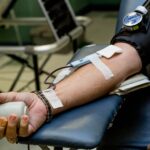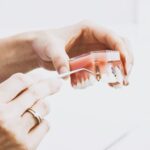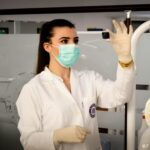 Thrombotic thrombocytopenic purpura (TTP) is a rare and life-threatening thrombotic microangiopathy characterized by microangiopathic hemolytic anemia, consumption thrombocytopenia, and organ injury. TTP pathophysiology is based on a severe ADAMTS13 deficiency, the specific von Willebrand factor (VWF)-cleaving protease. Expert opinion: Differential diagnosis of TTP may be challenging and ADAMTS13 investigations are needed. ADAMTS13 conformation could be a promising parameter for TTP diagnosis and prognosis in the coming years. Plasma therapy remains the first-line treatment of the acute phase of TTP. For more information click here.
Thrombotic thrombocytopenic purpura (TTP) is a rare and life-threatening thrombotic microangiopathy characterized by microangiopathic hemolytic anemia, consumption thrombocytopenia, and organ injury. TTP pathophysiology is based on a severe ADAMTS13 deficiency, the specific von Willebrand factor (VWF)-cleaving protease. Expert opinion: Differential diagnosis of TTP may be challenging and ADAMTS13 investigations are needed. ADAMTS13 conformation could be a promising parameter for TTP diagnosis and prognosis in the coming years. Plasma therapy remains the first-line treatment of the acute phase of TTP. For more information click here.
Publications
 Hypoparathyroidism is a rare endocrine disorder characterized by low or insufficient parathyroid hormone (PTH) concentrations leading to hypocalcemia, hyperphosphatemia, and markedly reduced bone turnover. Despite being a rare disease, hypoparathyroidism has a profound impact on affected patients. There is a female predominance, and anterior neck surgery is the most common etiology. Recent studies have better elucidated the chronic manifestations of the disease, impacting quality of life and multiple organ systems including the renal, cardiovascular, and skeletal systems. There are now data on longer term use of parathyroid hormone (PTH) and PTH analogs. This review focuses on recent contributions to the literature on the prevalence and epidemiology of the disease, risk of chronic manifestations, and treatment with PTH(1-34) and rhPTH(1-84). Further research is needed to determine the pathophysiology of complications in hypoparathyroidism and whether interventions can decrease future risk of these complications. In addition, further data are needed with regards to more physiologic dosing regimens and long-term treatment with PTH and PTH analogs. For more information click here.
Hypoparathyroidism is a rare endocrine disorder characterized by low or insufficient parathyroid hormone (PTH) concentrations leading to hypocalcemia, hyperphosphatemia, and markedly reduced bone turnover. Despite being a rare disease, hypoparathyroidism has a profound impact on affected patients. There is a female predominance, and anterior neck surgery is the most common etiology. Recent studies have better elucidated the chronic manifestations of the disease, impacting quality of life and multiple organ systems including the renal, cardiovascular, and skeletal systems. There are now data on longer term use of parathyroid hormone (PTH) and PTH analogs. This review focuses on recent contributions to the literature on the prevalence and epidemiology of the disease, risk of chronic manifestations, and treatment with PTH(1-34) and rhPTH(1-84). Further research is needed to determine the pathophysiology of complications in hypoparathyroidism and whether interventions can decrease future risk of these complications. In addition, further data are needed with regards to more physiologic dosing regimens and long-term treatment with PTH and PTH analogs. For more information click here.
 Balance impairment contributes to gait dysfunction, falls, and reduced quality of life in adults with Charcot-Marie-Tooth disease (CMT) but has been minimally examined in pediatric CMT. The CMT Pediatric Scale (CMTPedS) was administered to 520 children with CMT. Associations between balance function (Bruininks-Oseretsky Test of Motor Proficiency [BOT-2]) and sensorimotor and gait impairments were investigated. Balance impairment occurs from a young age in children with CMT. Balance intervention studies are required in pediatric CMT and should consider the degree of sensorimotor impairment, foot malalignment, and visual dependence. For more information click here.
Balance impairment contributes to gait dysfunction, falls, and reduced quality of life in adults with Charcot-Marie-Tooth disease (CMT) but has been minimally examined in pediatric CMT. The CMT Pediatric Scale (CMTPedS) was administered to 520 children with CMT. Associations between balance function (Bruininks-Oseretsky Test of Motor Proficiency [BOT-2]) and sensorimotor and gait impairments were investigated. Balance impairment occurs from a young age in children with CMT. Balance intervention studies are required in pediatric CMT and should consider the degree of sensorimotor impairment, foot malalignment, and visual dependence. For more information click here.
 Rare disease patients find independent health information seeking necessary due to the general lack of knowledge on rare diseases and inadequate information provision by health care professionals. The aim of this study is to describe distinctive aspects of health information behaviour of rare disease patients and specific challenges they face when seeking health information. A qualitative research approach was employed including semi-structured interviews that were analysed using thematic analysis. Fifteen respondents suffering from three different rare diseases participated in the study. Health information behaviour of rare disease patients is characterised by independent and continuous health information seeking and sharing. Connecting with other patients and getting realistic insight into the condition after diagnosis, advice for everyday life, comfort and hope and confirmation that their symptoms are ‘normal’ are of particular importance. Lack of specific advice for daily life, inaccessible new knowledge, lack of information about drugs and encountering severe health information are common challenges patients face due to insufficient support from health care professionals. Health information seeking and sharing are important aspects of rare disease patients’ everyday life. Challenges they face could be overcome in cooperation with patient support groups, health care professionals and health information professionals. For more information click here.
Rare disease patients find independent health information seeking necessary due to the general lack of knowledge on rare diseases and inadequate information provision by health care professionals. The aim of this study is to describe distinctive aspects of health information behaviour of rare disease patients and specific challenges they face when seeking health information. A qualitative research approach was employed including semi-structured interviews that were analysed using thematic analysis. Fifteen respondents suffering from three different rare diseases participated in the study. Health information behaviour of rare disease patients is characterised by independent and continuous health information seeking and sharing. Connecting with other patients and getting realistic insight into the condition after diagnosis, advice for everyday life, comfort and hope and confirmation that their symptoms are ‘normal’ are of particular importance. Lack of specific advice for daily life, inaccessible new knowledge, lack of information about drugs and encountering severe health information are common challenges patients face due to insufficient support from health care professionals. Health information seeking and sharing are important aspects of rare disease patients’ everyday life. Challenges they face could be overcome in cooperation with patient support groups, health care professionals and health information professionals. For more information click here.
 The team of the Institute for Rare Diseases has published a new scientific study. The aim of the study is to analyze the views of Bulgarian oncologists and hematologists regarding the value of innovative pharmaceutical treatments in their clinical area. Physicians were invited to review a life-prolonging scenario and to indicate what minimum improvement in median survival a new treatment would have to generate for them to recommend it over the standard of care. Respondents were also asked to state the highest cost at which they would recommend a new therapy that would improve patient’s health-related quality of life (HRQoL) but would have no impact on survival. In addition, physicians were asked whether they would consider different responses under certain circumstances. Responses were used to calculate incremental cost-effectiveness ratios (ICERs) for each scenario. They found a high willingness-to-pay for innovative drugs in oncology and hematology. The wide range of responses observed, however, indirectly implies a lack of consensus on the use of explicit ICER thresholds in Bulgaria. For more information click here.
The team of the Institute for Rare Diseases has published a new scientific study. The aim of the study is to analyze the views of Bulgarian oncologists and hematologists regarding the value of innovative pharmaceutical treatments in their clinical area. Physicians were invited to review a life-prolonging scenario and to indicate what minimum improvement in median survival a new treatment would have to generate for them to recommend it over the standard of care. Respondents were also asked to state the highest cost at which they would recommend a new therapy that would improve patient’s health-related quality of life (HRQoL) but would have no impact on survival. In addition, physicians were asked whether they would consider different responses under certain circumstances. Responses were used to calculate incremental cost-effectiveness ratios (ICERs) for each scenario. They found a high willingness-to-pay for innovative drugs in oncology and hematology. The wide range of responses observed, however, indirectly implies a lack of consensus on the use of explicit ICER thresholds in Bulgaria. For more information click here.
 The European Union defines a disease as rare when it affects fewer than 5 per 10 000 persons, whereas the USA considers a condition rare if it affects fewer than 200 000 individuals. To date, however, there is no terminology to appropriately address these diseases as a category other than rare diseases, or in some instances orphan diseases when referring to conditions that lack the resources for treatment discovery. For more information click here.
The European Union defines a disease as rare when it affects fewer than 5 per 10 000 persons, whereas the USA considers a condition rare if it affects fewer than 200 000 individuals. To date, however, there is no terminology to appropriately address these diseases as a category other than rare diseases, or in some instances orphan diseases when referring to conditions that lack the resources for treatment discovery. For more information click here.
 Marfan’s syndrome (MFS) is a systemic disorder of connective tissue caused by mutations in the
Marfan’s syndrome (MFS) is a systemic disorder of connective tissue caused by mutations in the
extracellular matrix protein fibrillin-1. Orofacial characteristics may be useful in identification of the syndrome. Severe periodontitis is sometimes observed in MFS patients, but no in-depth information has been reported in Italian groups of growing subjects with MFS. The aim of this study was to analyze the periodontal condition on a group of growing subjects affected by MFS, in comparison with a typically developed control group. A group of 16 subjects with diagnosed MFS were recruited from the Centre for Rare Diseases for Marfan Syndrome and Related Disorders of Tor Vergata University Hospital. The Marfan Group (MG) was compared with a Control Group (CG) composed by 20 nonsyndromic subjects. The periodontal clinical parameters like Marginal Gingival Thickness (GT), Plaque Index (PI), Bleeding On Probing (BOP) and Modified Periodontal Screening and Recording (PSR) were assessed. Patients with Marfan syndrome reveal a higher presence of plaque and consequently a generalized inflammation in the oral cavity when compared with a control group. For more information click here.
 The overall objective of this guideline is to provide the user with information on the laboratory diagnosis of inherited epidermolysis bullosa (EB) to improve outcomes. An accurate diagnosis and sub classification of EB enables early prognostication of the disease severity, decision making for patient management, informed genetic counselling of the patient and family and DNA based prenatal or preimplantation genetic diagnosis, long-term surveillance and management of possible complications, inclusion in clinical trials and precision medicine. The users of the guideline are dermatologists, neonatologists, paediatricians, geneticists and genetic counsellors, laboratory doctors and technicians, nurses and people living with EB and their families. The target group consists of patients with skin blistering or fragility, suspected of suffering from any type of EB. For more information click here.
The overall objective of this guideline is to provide the user with information on the laboratory diagnosis of inherited epidermolysis bullosa (EB) to improve outcomes. An accurate diagnosis and sub classification of EB enables early prognostication of the disease severity, decision making for patient management, informed genetic counselling of the patient and family and DNA based prenatal or preimplantation genetic diagnosis, long-term surveillance and management of possible complications, inclusion in clinical trials and precision medicine. The users of the guideline are dermatologists, neonatologists, paediatricians, geneticists and genetic counsellors, laboratory doctors and technicians, nurses and people living with EB and their families. The target group consists of patients with skin blistering or fragility, suspected of suffering from any type of EB. For more information click here.
 Rosai-Dorfman disease (RDD) with isolated central nervous system (CNS) involvement is an extremely rare disease. Most RDD of the CNS present as dural-based mass mimicking meningioma and other common lesions, which makes preoperative accurate diagnosis of great difficulty. We searched the pathology database in our hospital and 3 cases of RDD with isolated CNS involvement were finally included in our study. Radiological and clinical findings of these three cases were retrospectively analyzed. The lesions of 2 cases were dura-based against the cerebral convexity, presenting as a sheet-shaped thickened dura mater, another case was located just across the cerebral falx, the dural display in the center was intact. The 3 cases showed low signal intensity on T2-weighted image, obviously enhanced, significantly surrounding edema and finger-like protuberance but no invasion of the brain parenchyma or no sign of hyperplasia or sclerosis of the surrounding cranial bones. In conclusion, when we come across a disease that mimicking meningioma, especially when it manifests as the above radiological features, we should considered it might be a kind of proliferative disease of the meninges, such as RDD. For more information click here.
Rosai-Dorfman disease (RDD) with isolated central nervous system (CNS) involvement is an extremely rare disease. Most RDD of the CNS present as dural-based mass mimicking meningioma and other common lesions, which makes preoperative accurate diagnosis of great difficulty. We searched the pathology database in our hospital and 3 cases of RDD with isolated CNS involvement were finally included in our study. Radiological and clinical findings of these three cases were retrospectively analyzed. The lesions of 2 cases were dura-based against the cerebral convexity, presenting as a sheet-shaped thickened dura mater, another case was located just across the cerebral falx, the dural display in the center was intact. The 3 cases showed low signal intensity on T2-weighted image, obviously enhanced, significantly surrounding edema and finger-like protuberance but no invasion of the brain parenchyma or no sign of hyperplasia or sclerosis of the surrounding cranial bones. In conclusion, when we come across a disease that mimicking meningioma, especially when it manifests as the above radiological features, we should considered it might be a kind of proliferative disease of the meninges, such as RDD. For more information click here.
 Individuals with urea cycle disorders (UCDs) often present with intellectual and developmental disabilities. The major aim of this study was to evaluate the impact of diagnostic and therapeutic interventions on cognitive outcomes in UCDs..The mean cognitive standard deviation score (cSDS) was lower in symptomatic than in asymptomatic individuals with UCDs. In ornithine transcarbamylase and argininosuccinate synthetase 1 deficiencies, we did not find evidence that monoscavenger therapy with sodium or glycerol phenylbutyrate was superior to sodium benzoate in providing cognitive protection. Early liver transplantation appears to be beneficial for UCDs. It is noteworthy that individuals with argininosuccinate synthetase 1 and argininosuccinate lyase deficiencies identified by newborn screening had better neurocognitive outcomes than those diagnosed after the manifestation of first symptoms. Cognitive function is related to interventional and non-interventional variables. Early detection by newborn screening and early liver transplantation appear to offer greater cognitive protection, but none of the currently used nitrogen scavengers was superior with regard to long-term neurocognitive outcome. For more information click here.
Individuals with urea cycle disorders (UCDs) often present with intellectual and developmental disabilities. The major aim of this study was to evaluate the impact of diagnostic and therapeutic interventions on cognitive outcomes in UCDs..The mean cognitive standard deviation score (cSDS) was lower in symptomatic than in asymptomatic individuals with UCDs. In ornithine transcarbamylase and argininosuccinate synthetase 1 deficiencies, we did not find evidence that monoscavenger therapy with sodium or glycerol phenylbutyrate was superior to sodium benzoate in providing cognitive protection. Early liver transplantation appears to be beneficial for UCDs. It is noteworthy that individuals with argininosuccinate synthetase 1 and argininosuccinate lyase deficiencies identified by newborn screening had better neurocognitive outcomes than those diagnosed after the manifestation of first symptoms. Cognitive function is related to interventional and non-interventional variables. Early detection by newborn screening and early liver transplantation appear to offer greater cognitive protection, but none of the currently used nitrogen scavengers was superior with regard to long-term neurocognitive outcome. For more information click here.
